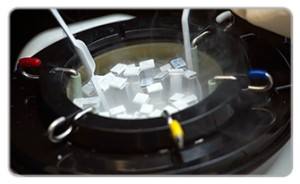Embryo Freezing
Embryo Freezing
Approximately 50% of patients have extra embryos following their IVF cycle. These embryos can be saved for future use, providing the opportunity for additional attempts at pregnancy from a single IVF cycle. Embryo freezing or cryopreservation allows embryos to be stored by cooling them to a very low temperature (-196oC) and storing them in liquid nitrogen. During the freezing process, the embryos are placed in solutions that gradually remove the water from their cells. This protects them from damaging ice crystal formation during freezing.

Vitrification is a method of cryopreservation that allows for ultra-rapid cooling of embryos, preventing the formation of damaging ice crystals. Vitrified embryos have better post-thaw survival rates and can result in higher pregnancy and live birth rates.
All precautions are taken to safeguard cryopreserved embryos and gametes (eggs and sperm). They are stored in special liquid nitrogen tanks that are alarmed 24/7 to detect any fluctuations in temperature and liquid nitrogen levels are checked daily to ensure appropriate levels are maintained, the development of these additional security levels and backup protocols have been created to ensure the highest standard of safety measures are in place. These processes used by the lab have been extensively assessed by Accreditation Canada. Our staff are considered to be providing an essential service by Alberta Health Services and are able to access the clinic daily to perform all the necessary tasks even if a lockdown of the city is declared.
The cost of embryo freezing and storage for the first year is included in the initial IVF fees. Fees for ongoing storage of embryos beyond the first year which fall in the middle of the range of fess currently being charged by other clinics in Canada are described here.
Check out our frequently asked questions (FAQ’s) for further information regarding cryostorage.
